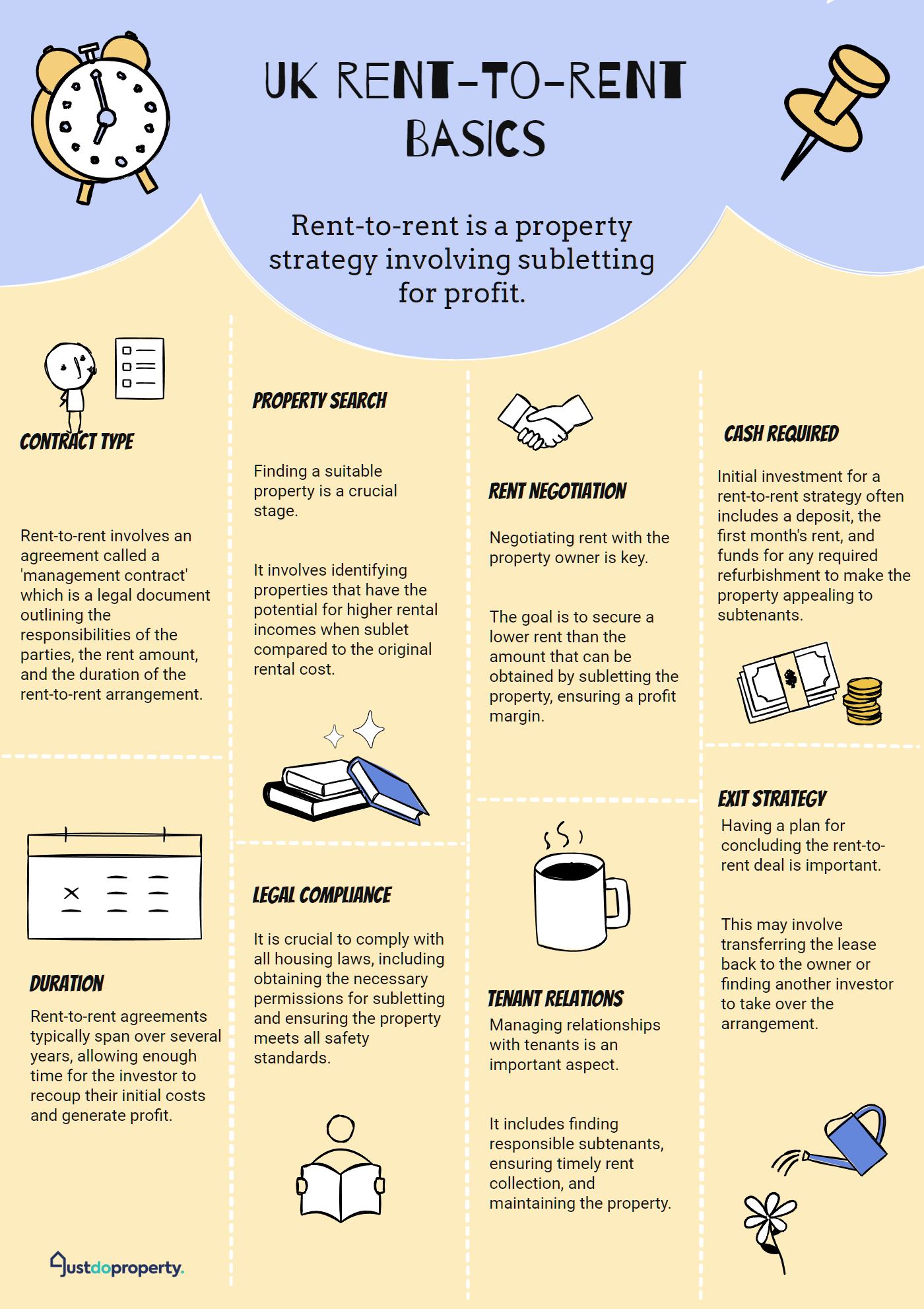If you’re looking to find rent-to-rent deals, start by focusing on properties that have been on the market for a while or ones that need some fixing up.
Look for places in popular areas that offer good rental returns.
Reach out directly to landlords with a well-crafted pitch that highlights the advantages for both sides. By negotiating terms that meet their requirements, you can turn a possible rejection into a successful deal.
Check out online listings and attend local networking events to find potential opportunities.
Don’t forget to tap into letting agents for inside scoops and exclusive offers.
Remember, persistence and clear communication are key to success in this venture.
By following these steps, you’ll soon uncover profitable rent-to-rent chances – there’s always more to explore!
Understanding Rent-to-Rent
Rent-to-Rent is a clever way to make money by renting a property from a landlord and then renting it out to tenants for a profit. It’s a low-risk way to start earning without needing a big upfront investment. But to do it right, you need to understand how to make money and what rules you need to follow.

Basically, you pay the landlord a set rent amount and pocket any extra money you make from renting it out to tenants. If you choose the right properties in popular areas or ones you can improve to raise the rent, you can make a nice profit. Just remember, making money is great, but you can’t ignore the rules.
When you’re doing Rent-to-Rent, you’re not just a renter; you’re like the property manager. That means you have to check if the original lease allows subletting, follow all the local rental laws, and have the right insurance in place. If you skip these legal steps, you could end up in expensive disputes or even facing legal trouble, which could really mess up your business and your relationships.
Benefits of Rent-to-Rent
Understanding the rules and responsibilities is crucial, but let’s focus on the perks of Rent-to-Rent to see why it’s so appealing to investors, whether they’re newbies or seasoned pros.
One major advantage is the potential for passive income. By securing a property through a rental agreement and then renting it out for a higher price, you can enjoy a steady cash flow without needing a hefty initial investment.
Rent-to-Rent also unlocks a plethora of property opportunities. Since you’re not buying the property outright, you can juggle multiple properties at once, spreading out your investments and reducing risks. This flexibility lets you explore new strategies and markets with minimal financial commitment, making it ideal for beginners or those looking to grow their current portfolio.
The attractive returns on investment from Rent-to-Rent deals are another big draw. With the right property and management in place, you can rake in significant income, swiftly boosting your financial position. This approach not only offers a fast track to generating cash flow but also helps you gain valuable experience in the real estate realm.
Identifying Potential Properties
When looking for properties to pursue a Rent-to-Rent strategy, it’s crucial to focus on the right kind of properties. Start by keeping an eye out for homes that have been lingering on the market for a while or have multiple listings. These signs often point to a landlord who’s eager to make a deal and may be open to unconventional agreements like Rent-to-Rent.
You’ll also want to target properties that require some TLC. These homes are typically priced lower, and landlords are usually more flexible when it comes to negotiations due to the property’s condition. This presents a great opportunity for you to propose a Rent-to-Rent arrangement that can benefit both you and the property owner.
The location of the property plays a significant role in the success of your Rent-to-Rent venture. Look for properties in sought-after areas with high rental yields. This ensures that your potential income is maximized, making your investment more profitable.
Additionally, consider exploring larger properties that can be converted into HMOs, as they can significantly increase your rental earnings.
To find these properties, make use of online property listing platforms and attend local networking events to connect with landlords looking to offload their properties. By focusing on these key aspects, you’ll be well-equipped to identify potential Rent-to-Rent properties and set yourself up for success.
Contacting Landlords Directly
When you reach out to landlords on your own, it’s important to create an email that clearly presents your proposal and the advantages of renting their property.
Establishing trust from the start is crucial, so make sure to be open and honest about your plans.
This not only sets the stage for potential negotiations but also lays the groundwork for a positive and collaborative partnership with the landlord.
Drafting Persuasive Email
Crafting a persuasive email to landlords is crucial for sealing Rent-to-Rent deals and leaving a lasting impression. When reaching out to landlords, it’s essential to nail email etiquette and persuasive writing.
Here’s how you can enhance landlord engagement through a well-crafted email:
- Catchy Subject Line: Kick things off with an attention-grabbing subject line. Try something like ‘Exciting Opportunity for Your [Property Address]’ to spark their interest.
- Personal Touch: Address the landlord by name and mention specific details about their property. This shows you’ve done your homework and are genuinely interested. For instance, ‘I came across your lovely property on Elm Street and would love to chat about a unique opportunity.’
- Emphasize the Benefits: Clearly outline the perks of a Rent-to-Rent agreement. Highlight the guaranteed rental income and how you’ll manage property upkeep. This addresses common landlord worries and showcases the value you offer.
Make sure to keep your email concise, professional, and respectful of their time.
Don’t forget to include your contact details and a call to action, like ‘I’m eager to discuss this further. Could we set up a call this week?’ This approach boosts the chances of a positive response, making landlord engagement smoother and more effective.
Building Trust Quickly
Building trust quickly with landlords is all about showing them you’re a reliable professional right off the bat. So, when you first get in touch, make sure your messages are clear, to the point, and packed with useful information. Put together a thorough proposal that explains the advantages of a Rent-to-Rent deal. This demonstrates that you’ve put in the effort to understand the benefits for them, laying a strong foundation for building trust fast.
Share your experience and accomplishments in property management. Give examples of how you’ve successfully handled similar agreements in the past. This kind of credibility boost goes a long way in building trust. Landlords feel more at ease when they know you’ve been down this road before and come out on top.
Be proactive in offering solutions to any issues the landlord may be facing with their property. Whether it’s finding tenants, taking care of maintenance problems, or managing current tenants, showing your problem-solving skills can really showcase your professionalism. This willingness to work together for a win-win situation speaks volumes about your dependability.
Don’t forget to provide references or testimonials from previous landlords. These endorsements of your track record can be a game-changer in building trust. When landlords see that others have had positive experiences working with you, it gives them the confidence to move forward.
Negotiating Terms
When negotiating a rent-to-rent deal, it’s important to first understand what the landlord needs and why they’re looking for this arrangement. By tailoring your offer to meet their specific concerns, you show that you’re invested in a mutually beneficial partnership. Building a good relationship with the landlord is key, so be genuine, show interest, and empathize with their situation to foster cooperation.
Now, let’s talk about setting clear boundaries and expectations. It’s crucial to define roles and responsibilities upfront, whether it’s about property maintenance, management, or dealing with tenants. Transparency at this stage helps avoid conflicts later on.
Here are three practical steps to guide your negotiation:
- Show the Benefits for Both: Make sure to highlight how a guaranteed rent or property management services can be a win-win situation. By emphasizing mutual advantages, you make the deal more appealing to the landlord.
- Stay Flexible: Being open to compromise and finding common ground is key. Flexibility can make the negotiation process smoother and reinforce a sense of teamwork.
- Get Legal Advice: Before sealing the deal, it’s wise to seek advice from a legal professional to ensure the terms are fair and legally binding. This step adds a layer of protection for both parties involved.
Creative Financing Strategies
Getting creative with financing strategies can make your rent-to-rent offer a landlord’s dream. By offering attractive financing options and incentives, you can make your deal stand out. One winning tactic is to guarantee rent payments, giving landlords a reliable income stream without the headaches of managing tenants.
When you’re at the negotiating table, focus on the perks of structured payment plans. You might suggest a higher rental income than they currently get, but with the security of on-time payments every month. This could sway landlords, especially if they’ve dealt with unreliable tenants before.
Face-to-face talks are key. They let you clearly explain the benefits of your financing plan. Use negotiation skills that highlight how the deal is a win-win for both sides. Show how your offer not only meets but surpasses their expectations.
Make sure the financial perks are crystal clear. Outline how your rent-to-rent arrangement offers stability and the potential for increased earnings. When landlords see the concrete advantages, they’re more likely to say yes to your proposal, setting the stage for a successful agreement.
Analyzing Rent-to-Rent Deals
When you’re looking at Rent-to-Rent deals, start by thinking about where the property is and how much people want to rent there.
Then, figure out how much money you could make by comparing what you’d earn in rent to all the costs of running the place, like utilities and repairs.
This way, you can see which deals would actually make you money and are worth going after.
Evaluating Property Potential
When you start looking at a property’s potential, the first thing to consider is where it’s located. Think about the neighborhood, what’s nearby, and how appealing it is. If it’s in a popular area with good transport links and schools, chances are you’ll have lots of people interested in renting it.
Next up, check out the demand for rentals in the area. Look at how many properties are being rented out and how quickly they get snapped up. If there’s a high demand, you’ll have fewer empty periods and a more stable income stream.
Lastly, take a peek at the market trends. See what rental rates are like in that neighborhood and compare them to what you’ll be spending. This will help you figure out how much profit you can expect.
Here’s a simple way to get started:
- Location Check: Hunt for properties in popular spots with good amenities.
- Demand Check: Scope out local rental listings and chat with property managers to gauge interest.
- Market Check: Keep an eye on rental trends to ensure a steady flow of income.
Calculating Profit Margins
Now that you’ve figured out the potential of the property, it’s time to do some number crunching to see if a Rent-to-Rent deal is worth it. Start by listing all your monthly expenses like maintenance, utilities, and management fees. Subtract these from the rental income to see how much you’re really making.
Remember to account for possible income changes and times when the property might be vacant. This will help you make accurate profit predictions. Aim for a profit margin of at least 20% to ensure the deal is solid and worth your time. This extra wiggle room will help cover any surprise expenses and keep your investment safe.
Tools like spreadsheets or online calculators can make this process easier. They help you keep your data organized and see how different scenarios might play out. Having a well-documented financial analysis will also help you make smart choices and avoid costly errors.
Utilizing Letting Agents
Working with letting agents can make your search for rent-to-rent deals a lot easier. When you build relationships with letting agents, you get access to valuable insights that can give you an edge over others. These agents often know about properties that aren’t yet listed publicly, giving you a head start in finding profitable opportunities.
Here are three practical reasons to team up with letting agents:
- Market Insights: Letting agents are in tune with the rental market, so they can provide you with the latest information on available properties and rental trends. This knowledge helps you make smart decisions and identify the best deals.
- Exclusive Deals: By forming good relationships with agents, you can get early access to properties before they’re officially on the market. This insider knowledge can mean the difference between securing a great deal or missing out.
- Negotiation Support: Letting agents can negotiate with landlords on your behalf, saving you time and energy. They understand what landlords want and how to present your rent-to-rent proposal effectively.
Working with letting agents not only simplifies your search but also increases your chances of finding profitable rent-to-rent deals.
Staying Persistent
Building strong relationships with letting agents is important, but it’s just one piece of the puzzle. Staying persistent is equally crucial when it comes to securing rent-to-rent deals. You need to be prepared for the long haul, consistently following up on leads and actively searching for hidden opportunities. The key is to keep up a steady effort and never miss a chance to explore a potential deal.
To help you stay focused, here’s a simple breakdown of key actions:
- Consistent Follow-Ups: Check in weekly to uncover hidden gems.
- Proactive Contacts: Reach out every two weeks to secure profitable deals.
- Network Building: Dedicate time monthly to expand your opportunities.
By staying on top of follow-ups, you demonstrate your dedication and professionalism to landlords and agents. This persistence can open the door to more lucrative deals, putting you ahead of the competition.
Maintaining a positive mindset is crucial. Even when faced with challenges, keep pushing forward to find new leads. By staying connected with industry contacts and growing your network, you increase your chances of discovering those valuable rent-to-rent opportunities. Stay persistent, and you’ll see the results you’re looking for.
Conclusion
When you’re on the lookout for great rent-to-rent deals, just remember that persistence really does pay off. Believe it or not, almost 30% of landlords are actually open to different leasing arrangements like rent-to-rent.
By getting creative with your financing and honing your negotiation skills, you can turn these opportunities into profitable ventures. Make sure to thoroughly analyze each deal and don’t be afraid to ask letting agents for assistance.
Keep at it, and before you know it, you’ll start reaping the rewards. Happy hunting!
- Rent-to-Rent Schemes: Hidden Dangers Lurk - July 6, 2024
- How to Sell Your House Fast in Kent - July 5, 2024
- 7 Tips to Sell Your House Fast - July 4, 2024


